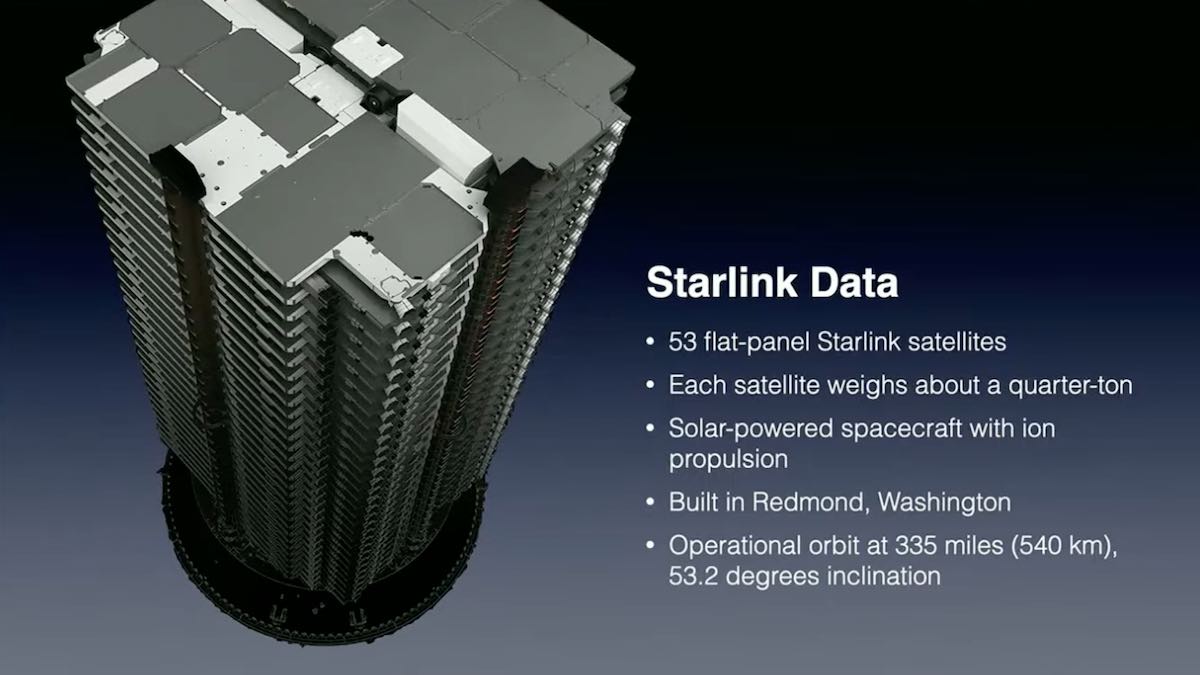Live coverage of the countdown and launch of a SpaceX Falcon 9 rocket from Space Launch Complex 40 at Cape Canaveral Space Force Station in Florida. The Starlink 4-27 mission will launch SpaceX’s next batch of 53 Starlink broadband satellites. Follow us on Twitter.
SFN Live
SpaceX launched another batch of 53 Starlink internet satellites Friday from Cape Canaveral Space Force Station in Florida. A Falcon 9 rocket lifted off at 3:21 p.m. EDT (1921 GMT) to loft the Starlink payloads into orbit, and the reusable first stage booster landed on a drone ship in the Atlantic Ocean.
The Falcon 9 rocket headed northeast from the Kennedy Space Center, aiming to deliver the flat-packed broadband relay stations to an orbit ranging between 144 miles and 208 miles in altitude (232-by-336 kilometers). Deployment of the 53 flat-packed satellites from the Falcon 9’s upper stage occurred about 15 minutes after liftoff.
With Friday’s mission, designated Starlink 4-27, SpaceX has launched 3,108 Starlink internet satellites, including prototypes and test units no longer in service. The launch Tuesday was the 56th SpaceX mission primarily dedicated to hauling Starlink internet satellites into orbit.
Stationed inside a launch control center just south of Cape Canaveral Space Force Station, SpaceX’s launch team began loading super-chilled, densified kerosene and liquid oxygen propellants into the 229-foot-tall (70-meter) Falcon 9 vehicle at T-minus 35 minutes.
Helium pressurant also flowed into the rocket in the last half-hour of the countdown. In the final seven minutes before liftoff, the Falcon 9’s Merlin main engines were thermally conditioned for flight through a procedure known as “chilldown.” The Falcon 9’s guidance and range safety systems were also configured for launch.
After liftoff, the Falcon 9 rocket vectored its 1.7 million pounds of thrust — produced by nine Merlin engines — to steer northeast over the Atlantic Ocean.
The rocket exceeded the speed of sound in about one minute, then shut down its nine main engines two-and-a-half minutes after liftoff. The booster stage released from the Falcon 9’s upper stage, then fired pulses from cold gas control thrusters and extended titanium grid fins to help steer the vehicle back into the atmosphere.
Two braking burns slowed the rocket for landing on the drone ship “A Shortfall of Gravitas” around 400 miles (650 kilometers) downrange approximately eight-and-a-half minutes after liftoff.

The first stage for Friday’s launch is designated B1062 in SpaceX’s inventory. The booster’s first launch was on Nov. 5, 2020, with a U.S. military GPS navigation satellite. Since then, the rocket has now launched two commercial astronaut missions, another GPS satellite, the Egyptian Nilesat 301 communications spacecraft, and four Starlink missions.
The Falcon 9’s reusable payload fairing jettisoned during the second stage burn. A recovery ship was also on station in the Atlantic to retrieve the two halves of the nose cone after they splash down under parachutes.
Landing of the first stage on Tuesday’s mission occurred moments after the Falcon 9’s second stage engine cut off to deliver the Starlink satellites into orbit. Separation of the 53 spacecraft, built by SpaceX in Redmond, Washington, from the Falcon 9 rocket was confirmed at T+plus 15 minutes, 15 seconds.
Retention rods released from the Starlink payload stack, allowing the flat-packed satellites to fly free from the Falcon 9’s upper stage in orbit. The 53 spacecraft will unfurl solar arrays and run through automated activation steps, then use krypton-fueled ion engines to maneuver into their operational orbit.
The Falcon 9’s guidance computer aimed deploy the satellites into an elliptical orbit at an inclination of 53.2 degrees to the equator. The satellites will use on-board propulsion to do the rest of the work to reach a circular orbit 335 miles (540 kilometers) above Earth.
The Starlink satellites will fly in one of five orbital “shells” at different inclinations for SpaceX’s global internet network. After reaching their operational orbit, the satellites will enter commercial service and begin beaming broadband signals to consumers, who can purchase Starlink service and connect to the network with a SpaceX-supplied ground terminal.
ROCKET: Falcon 9 (B1062.9)
PAYLOAD: 53 Starlink satellites (Starlink 4-27)
LAUNCH SITE: SLC-40, Cape Canaveral Space Force Station, Florida
LAUNCH DATE: Aug. 19, 2022
LAUNCH TIME: 3:21:20 p.m. EDT (1921:20 GMT)
WEATHER FORECAST: 50% chance of acceptable weather; Low risk of upper level winds; Low risk of unfavorable conditions for booster recovery
BOOSTER RECOVERY: “A Shortfall of Gravitas” drone ship east of Charleston, South Carolina
LAUNCH AZIMUTH: Northeast
TARGET ORBIT: 144 miles by 208 miles (232 kilometers by 336 kilometers), 53.2 degrees inclination
LAUNCH TIMELINE:
- T+00:00: Liftoff
- T+01:12: Maximum aerodynamic pressure (Max-Q)
- T+02:28: First stage main engine cutoff (MECO)
- T+02:32: Stage separation
- T+02:38: Second stage engine ignition
- T+02:43: Fairing jettison
- T+06:49: First stage entry burn ignition (three engines)
- T+07:08: First stage entry burn cutoff
- T+08:29: First stage landing burn ignition (one engine)
- T+08:33: Second stage engine cutoff (SECO 1)
- T+08:49: First stage landing
- T+15:15: Starlink satellite separation
MISSION STATS:
- 171st launch of a Falcon 9 rocket since 2010
- 179th launch of Falcon rocket family since 2006
- 9th launch of Falcon 9 booster B1062
- 147th Falcon 9 launch from Florida’s Space Coast
- 94th Falcon 9 launch from pad 40
- 149th launch overall from pad 40
- 113th flight of a reused Falcon 9 booster
- 56th dedicated Falcon 9 launch with Starlink satellites
- 37th Falcon 9 launch of 2022
- 37th launch by SpaceX in 2022
- 36th orbital launch attempt based out of Cape Canaveral in 2022
Email the author.
Follow Stephen Clark on Twitter: @StephenClark1.
